GOLDSCHMIDT, Victor.
(1853 – 1933)
Goldschmidt began as a student of metallurgy at the Industrial Academy in Berlin and the Freiberg Bergakademie, but in 1880, he graduated with a Ph.D. in mineralogy from the University of Heidelberg. In 1888, he married Leontine Porges, who supported her husband and his students. In 1888, Goldschmidt also became a faculty member of the University of Heidelberg. There he founded the Mineralogical-Crystallographic Institute.
Biographical references: American Journal of Science: 5th Series, 26 (1934), 96. • Barr, Index to Biographical Fragments, 1973: 100. • Brunschwig, J., et al., A la memoire de Victor Goldschmidt. Etudes reunies par Jacques Brunschwig, Claude Imbert et Alain Roger. Paris, J. Vrin, 1985. 334 p. [In English and French. Bibliographies are included.]. • DBA: II 463, 276-289. • DSB: 5, 455-6 [by G.C. Amstutz]. • NDB: 6, 612 [by F. Herrmann]. • Poggendorff: 3, 530, 4, 510, 5, 435-6 & 6, ???. • Sarjeant, Geologists, 1980: 2, 1114 & Suppl. 2 (1996), 1, 661. • Schiffner, Alter Freiberger Bergstudenten, 1935-40: 1, 348-51, portrait. • Schlichtenberger, C., "Harmony and complication. The collection of Victor Goldschmidt, founder of the ethnographic museum of the J. u. E. von Portheim-Stiftung in Heidelberg", Journal of the History of Collections, 10, (1998), no. 2, 199-206. • WBI. • World Who's Who in Science: 672.
1. German, 1880 [Dissertation].
Ueber verwendbarkeit einer Kaliumquecksilberjodidlösung bei mineralogischen und petrographischen Untersuchungen ... Stuttgart: E. Schweizerbart'sche Verlagshandlung (E. Koch), 1880.
8°: [2], 60 p., 3 double-plates (numbered I-III), illus.
Rare. Goldschmidt's Inagrual dissertation concerning the accurate determination of the specific gravity of minerals. This is a study he returned to in several articles throuhout his career.
Bibliographical references: NUC: 204, 613-6 [NG 0294661].
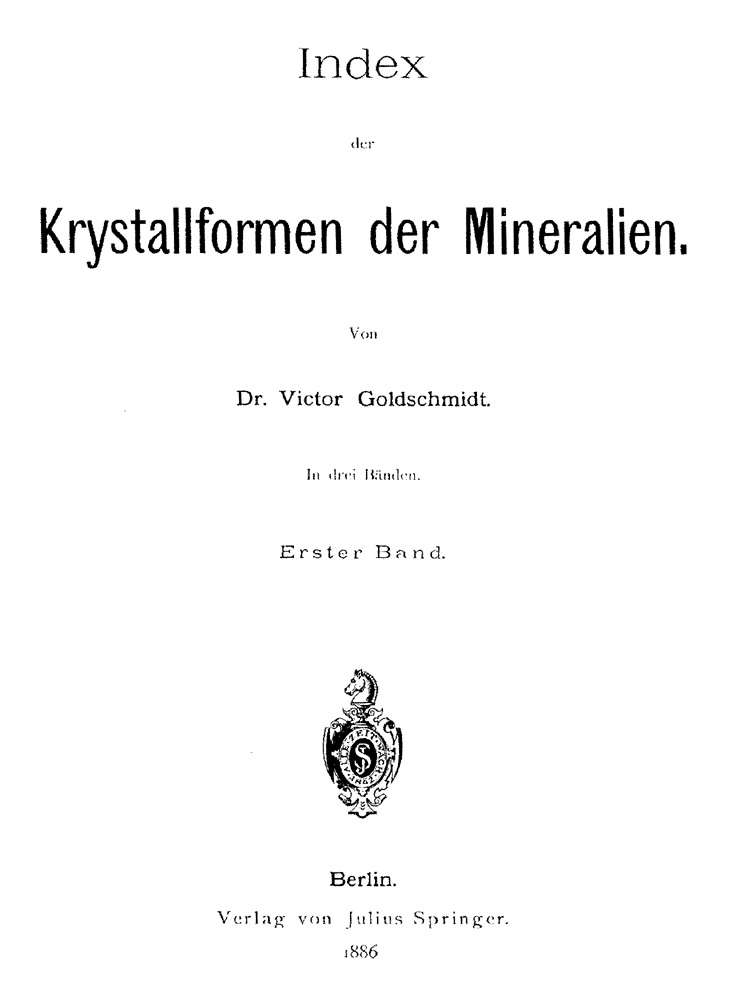
2. German, 1886-91.
Index | der | Kristallformen der Mineralien. | Von | Dr. Victor Goldschmidt. | [rule] | In drei Bänden. | [rule] | Erster [-Dritter] Band. | [ornament] | Berlin. | Verlag von Julius Springer. | 1886 [-1891].
3 vols. [Vol 1] π5 1-378 385; ??l.; [i]-x, [1]-601 (pages 593-601 printed recto only) p., 99 text illus., tables, diagrms., biblio. (pages 150-53). [Vol 2] π2 1-358 364; ??l.; [4], 1-546 p., tables.; [Vol 3] π4 1-318 χ1; ??l.; [i]-vii, [1] blank, 1-420 (pages 397-420 printed recto side only) p., tables. Page size: 245 x 162 mm.
Contents: [Vol 1] [i-ii], Title page, verso "Wilhelm Gronau's Buchdruckerei in Berlin."; [iii], Dedication to Albin Weisbach.; [iv], Blank.; [v]-vi, "Vorwort."-dated August 1886.; [viii]-x, "Inhalt des ersten Bandes."; [1]-156, Introductory text.; [157], "Index."; [158], Blank.; 159-592, Tables of crystal forms for the minerals abichite to euxenite.; [593]-601, "Correcturen und Nachträge."
[Vol 2] [2 pgs], Title page, verso blank.; [1 pg], "Vorbemerkung"-dated April 1890.; [1 pg], Blank.; 1-546, Tables of crystal forms for the minerals "Fahlerz" (tetrahedrite) to babingtonite.
[Vol 3] [i-ii], Title page, verso blank.; [iii]-v, "Vorwort."-dated May 1891.; [vi], "Inhalt des dritten Bandes."; vii, "Erklärung und Zeichen."; [1 pg], Blank.; 1-362, Tables of crystal forms for the minerals quartz to zunyite.; [363], "Anhang."; [364], "Der Anhang enthählt die Mineralien mit unvollständig bestimmten Elementen, ..."; [365]-391, Text.; [392]-396, "Synonyme."; [397]-420, "Correcturen und Nachträge."
Very scarce. A remarkable crystallographic work that attempted to index every mineral crystal form. In volume one, the first 156 pages are devoted to a treatise on crystallography that was also separately published as Einleitung in die formbeschreibende Krystallographie (Berlin, 1887) [which see next entry]. This introductory section covers symbols, projections, transformations, calculation of elements, tables, and abbreviations. Next follows the systematic data for minerals arranged alphabetically from abichite to euxenite. For each mineral listed the crystal system, axial ratios, cell elements, etc. are given. The next two volumes continue these listings for the other minerals. At the conclusion of volume three is a supplement listing synonyms and corrections. The work was issued in a series of sections. Volume one appeared in two Lieferungen 1. Einleitung & 2. Abichit to Euxenit. Volume two was published in seven Hefts covering the minerals Fahlerz to Pyroxen. The concluding volume also appeared in 7 Hefts, with the first 6 dealing with the minerals Quarz to Zunyit. The last Heft was a supplement.
Bibliographical references: American Journal of Science: 3rd Series, 35 (1888), 501. • Dana's 7th (Bibliography): 72. • NUC: 204, 613-6 [NG 0294647].
3. German, 1887.
Einleitung in die formbeschreibende Krystallographie ... Sonderausgabe der Einleitung zum Index der Krystallformen der Mineralien. Berlin, Julius Springer, 1887.
8°: [4], 156 p., 92 text illus.
Very scarce. This work is the separately issued introduction to Goldschmidt's Index der Krystallformen der Mineralien (3 vols., Berlin, 1887-91) [which see entry above], with a different title page.
Bibliographical references: NUC: 204, 613-6 [NG 0294640].
4. German, 1887.
Krystallographische Projectionsbilder, von Dr. Victor Goldschmidt. Zum Theil in Farbendruck. Berlin, Julius Springer, 1887.
[Text] 4°: 15, [1] p.; [Atlas] 2°: [2], XIX (i.e., 21) plates. Page size: Text: 230 x 180 mm.; Atlas: 780 x 680 mm.
Plates: The plates comprise: I. Pyrit. Gnomonische Projection der bekannten Formen. II. Pyrit. Punktbild. III. Calcit. Gnomonische Projection IV. Calcit. Punktbild. V. Rothgiltigerz. Gnomonische Projection der bekannt Formen. VI. Rothgiltgerz. Punktbild. VII. Pyrit, Calcit, Rothgiltigerz. Mittelfelder in grössere Massstab. (Ergänzungsblatt.) VIII. Eisenglanz. Gnomonische Projection der bekannten Formen. IX. Eisenglanz. Punktbild. X. Quarz. Gnomonische Projection der bekannten Formen. XI. Quarz. Punktbild. XII. Quarz. Mittelfeld in grösserem Massstab. XIII. Bournonit. Gnomonische Projection der bekannten Formen. XIV. Bournonit. Punktbild. XV. Humit-Gruppe: Humit, Klinohumit, Chondrodit. Gnomonische Projection der bekannten Formen. XVI. Humit-Gruppe: Humit, Klinohumit, Chondrodit. Punktbild mit optischen Abmessungen. XVII. Magneteisenerz, Beryll, Idokras, Baryt, Epidot, Axinit. Beispiele für die Anwendung rastrirter Blätter zur Darstellung von Projectionsbildern. XVIII. Amphibol. Ableitung des perspectivischen und des horizontalen Bildes aus dem gnomonischen Projectionsbild. XIX. Anorthit. Zwillingsbilder in gnomonischer Projection. Albit-Gesetz, Manebacher-Gesetz. Calcit, Rothgiltigerz, Eisenglanz, Quarz. Linienbilder der wichtigsten Zonenentwickelung. Beilagen I. Hexagonales Netz. Beilagen II. Tetragonales Netz.
Very rare. This rare set is an exceptional and unique work in crystallography. It was a by-product of Goldschmidt's extraordinary compilation Index der Krystallformen der Mineralien (3 vols., Berlin, 1886-91), which listed the known crystal forms for many minerals. The Krystallographische Projectionsbilder uses the forms of some of the minerals listed in the earlier work and plots them in goniometric projection. Because the minerals Goldschmidt choose to publish in this fashion had tremendous variety in their crystal forms, the only practical method of conveying the rich variety of forms on one projection was to use a very large format in the publication of the atlas, and it is. Measuring 78 x 68 cm, or over 2.5 x 2 feet, the plates of this work display the culmination of goniometeric projection. In the time preceeding x-ray diffraction, the only method available to describe the exact symmetry of crystallographic data was to measure crystal faces on a goniometer. The measurements obtained were then conveyed to other researchers in a number of ways the most computational of which was the goniometric projection. This procedure involved projecting an imaginary axis orthogonal from a measured crystal face to the surface of a hemisphere lying outside the crystal. Where the axis projection intersected the sphere an imaginary point was created on the surface of the sphere. These points were then plotted on to a special graph known as a Wulff net. By this means a simplified visual picture of the crystal symmetry and form is produced. In addition, if other crystal forms of the same mineral are projected on to the same circle, a very visual, simplified picture of all the species crystal forms is created. This allowed any research who thought they had discovered a new crystal form to check its projection against Goldschmidt's work and quickly determine if in fact a new form had been discovered.
Bibliographical references: BL [no copy listed]. • NUC: 204, 613-6 [NG 0294648].
5. German, 1887.
Ueber krystallographische demonstration mit Hilfe von Korkmodellen mit farbigen Nadelstiften. Von Dr. Victor Goldschmidt ... Berlin, Julius Springer, 1887.
8°: 20 p., 6 colored plates (numbered I-VI).
Very scarce. An ingenious device for the purpose of demonstating by use of cork blocks with needles bearing colored heads to show the symmetry of the different crystal systems and the relation of the forms belonging to them.
Bibliographical references: American Journal of Science: 3rd Series, 35 (1888), 501. • NUC: 204, 613-6 [NG 0294659].
6. German, 1887.
Ueber projection und graphische Krystallberchnung. Von Dr. Victor Goldschmidt ... Berlin, Julius Springer, 1887.
8°: [2], [4], 97, [2] p., 123 text illus.
Very scarce. The scheme of notation with the methods of projection and calculation that Goldschmidt had developed in the introduction to his Index der Krystalformen (3 vols., Berlin, 1886-91) is further elucidated in this work.
Bibliographical references: American Journal of Science: 3rd Series, 35 (1888), 501. • NUC: 204, 613-6 [NG 0294660].
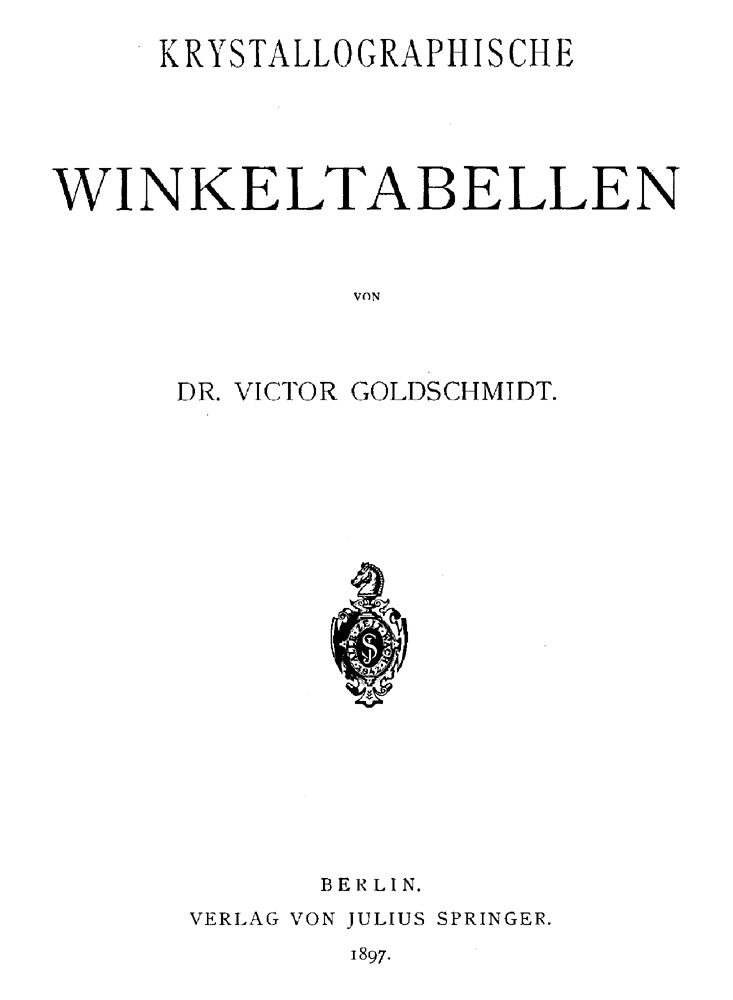
7. German, 1897.
Krystallographische | Winkeltabellen | von | Dr. Victor Goldschmidt. | [ornament] | Berlin. | Verlag Von Julius Springer. | 1897.
4°: π1 1-278; 217l.; [2], [1]-432 p., folding diagram (page 19, labeled 19a & 19b), 25 illus., index. Page size: 252 x 175 mm.
Contents: [2 pgs], Title page, verso "Alle rechte, insbesondere das der Übersetzung in fremde Sprachen vorbehalten. | ..."; [1]-26, "Einleitung."-dated 16 July 1896.; [27], "Winkeltabellen."; [28], Blank.; 29-380, Text (tables of mineral crystal forms).; [381], "Anhang. | Bemerkungen und Correcturen."; [382], Blank.; 383-426, Text of commentary and corrections.; [427]-432, "Synonyme. | ..."
Very scarce. Krystallographische Winkeltabellen presented for the first time a complete table of angles for all the crystal forms of all crystallized mineral species. Such tables were useful to the crystallographer to determine without calculation whether the forms observed on a crystal were already known or were new. Short approximations to these tables had appeared within monographs for single mineral species, but no one before this work had attempted the mineral kingdom as a whole. It had been impractical because the prevailing method was to list the interfacial measurements between crystal faces which for any given form required an enormous number of angles to be given. However, the invention of the two-circle goniometer first proposed by Evgraf S. Fyodorov [q.v.] and constructed by the mechanic Peter Stoë [?-1931] for Goldschmidt allowed each face of a crystal to be measured independently of all others. The crystal's position was determined with reference to a fixed pole and meridian by two angular coordinates making it possible to create a complete table of angles. For such a table now need only contain for each form two angular values, $ρ$ and $φ$ (corresponding to geographical longitude and latitude for a point on the earth's surface). Kristallographische Winkeltabellen contain these values for each well established crystal form of each mineral calculated from the axial elements of the substance and the symbol of the form. There are also given for each form several angles that facilitate the comparision of these angular coordinates with the results of the ordinary interfacial measurement. Lastly a set of linear coordinates enable the rapid plotting of the form in a gnomonic projection. The introduction to the work gives the necessary explanations of the values contained in the work, and the schemes employed in each system for the calculation of the values are shown. Some idea of the enormous labor employed by Goldschmidt in this work is given by the statement that it contain upwards of 70,000 values. Of this number about half are values recurring more or less often, such as angles of 45° and 60°, but of the remaining each required a separate calculation. An appendix contains notes on the various minerals, indicating the particular orientation adopted in each case.
Bibliographical references: American Journal of Science: 4th Series, 5 (1898), 153-4 [by C. Palache]. • Mineralogical Magazine: 12 (18??), 43 [by H.A. Miers]. • NUC: 204, 613-6 [NG 0294649].
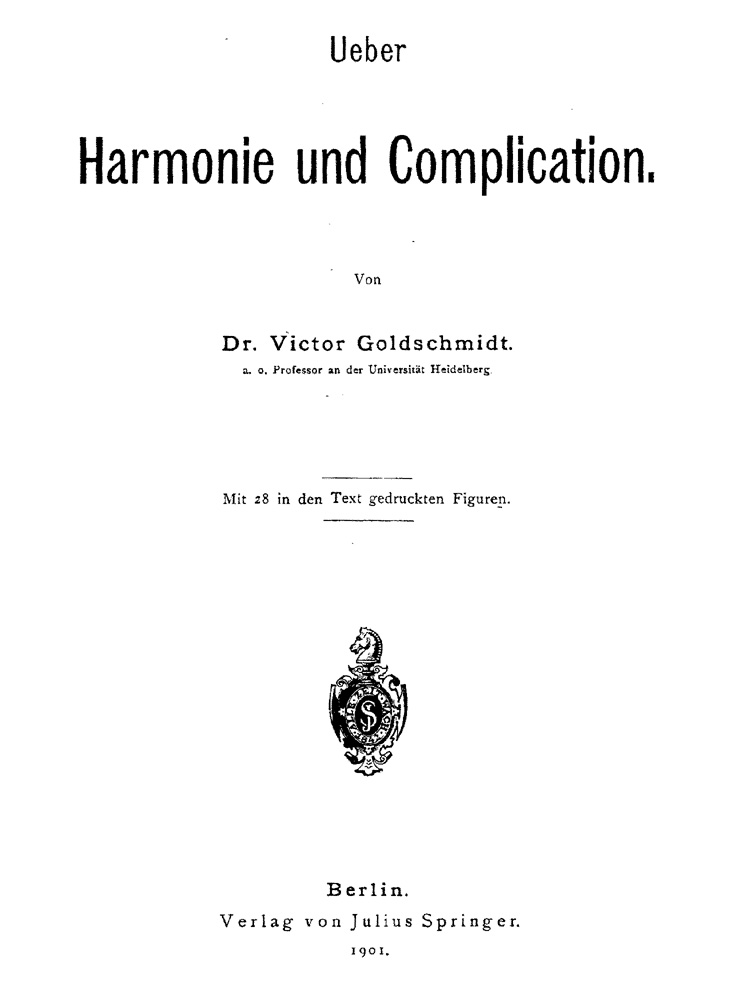
8. German, 1901.
Ueber | Harmonie und Complication. | Von | Dr. Victor Goldschmidt. | a.o. Professor and der Universität Heidelberg. | [rule] | Mit 28 in den Text gedruckten Figuren. | [rule] | [ornament] | Berlin. | Verlag von Julius Springer. | 1901.
8°: π3 1-88 95; 72l.; [i]-iv, [1] contents, [1] blank, [1]-136, [2] p., one folding musical sheet as an extension of the leaf containing pages 53 & 54. Page size: 252 x 174 mm.
Contents: [i-ii], Title page, verso two quotes (one from Goethe, the other from Pythagoras).; [iii]-iv, "Vorwort."; [1 pg], "Inhalt."-signed V. Goldschmidt, December 1901.; [1 pg], Blank.; [1]-136, Text.; [2 pgs], Publisher advertisements for the author's other works published by Julius Springer in Berlin.
Very scarce. In this strange theoretical crystallography, Goldschmidt attempts to relate musical harmony with the symmetry of crystals and the preception of color. As a counterpoint he then discusses complications found in nature, art and counting systems. Goldschmidt wrote in the preface that the essentials of this book had been written down by 1893, but in an effort to make this complex thesis more complete, he had continued to add new material until publication.
Bibliographical references: American Journal of Science: 4th Series, 12 (1901), 325. • NUC: 204, 613-6 [NG 0294658].
9. German, 1902.
Erinnerungsblätter an Albin Weisbach, Geheimen Bergrath und Professor der Mineralogie an der Kgl. Bergakademie in Freiberg in Sachsen. Von Dr. Victor Goldschmidt ... Freiberg in Sachsen, Craz & Gerlach, 1902.
8°: 30 p., frontispiece (portrait of Weisbach).
Very scarce. Memorial to Albin Weisbach prepared by his favorite student. Weisbach was a great influence in Goldschmidt's life. While atttending the University of ???, Goldschmidt came under Weisbach's influence. Goldschmidt was so inspired, he decided to make the study of crystallography his life's work. The relationship between these two is also clearly shown by Goldschmidt's dedication of the Index der Kristallformen der Mineralien to Weisbach.
Bibliographical references: NUC: 204, 613-6 [NG 0294642].
Der Diamant. Eine Studie von A. von Fersmann und V. Goldschmidt ... Mit einem Atlas von 43 Tafeln. (Heidelberg, 1911).See under: Fersman, Aleksandr Evgenievich.
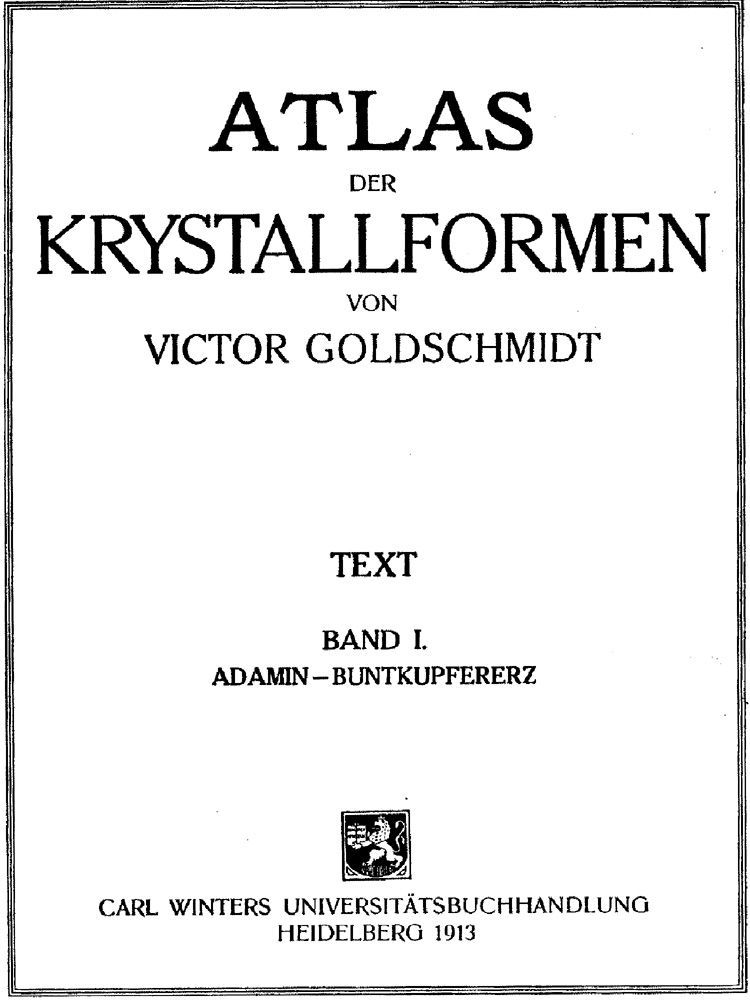
10. German, 1913-23.
[Contained within a triple rule box:] Atlas | Der | Krystallformen | Von | Victor Goldschmidt | Text [-Tafeln] | Band I. [-IX.] | Adamin-Buntkupfererz [-Trechmannit-Zoisit]. | [ornament] | Carl Winters Universitätsbuchhandlung | Heidelberg 1913 [-1923].
9 vols. bound in 18. [Vol 1: 1913] (Text) 4°: [2], [i]-vi, 1-248 p., tables.; (Plates) 4°: [4] p., plates 1-244.; [Vol 2: 1913] (Text) 4°: [2], 1-200 p., tables.; (Plates) 4°: [2] p., plates 1-251, [1] blank p.; [Vol 3: 1916] (Text) 4°: [2], 1-240 p., tables.; (Plates) 4°: [2] p., plates 1-247, [1] blank p.; [Vol 4: 1918] (Text) 4°: [2], 1-212 p., tables.; (Plates) 4°: [2] p., plates 1-133, [1] p.; [Vol 5: 1918] (Text) 4°: [2], 1-199, [1] p., tables.; (Plates) 4°: [2] p., plates 1-123, [1] p.; [Vol 6: 1920] (Text) 4°: [2], 1-208 p., tables.; (Plates) 4°: [2] p., plates 1-144.; [Vol 7: 1922] (Text) 4°: [2], 1-175, [1] p., tables.; (Plates) 4°: [2] p., plates 1-159, [1] blank p.; [Vol 8: 1922] (Text) 4°: [2], 1-195, [1] p., tables.; (Plates) 4°: [2] p., plates 1-149, [1] p.; [Vol 9: 1923] (Text) 4°: [2], 1-192, [2] p., tables.; (Plates) 4°: [2] p., plates 1-128.
Contents: [Vol 1] (Text) [2 pgs], Title page, verso blank.; [i], Dedication to Mrs. Goldschmidt.; [iii], Blank.; [iv]-vi, "Vorwort zum ersten Band."-dated November 1912.; 1-248, Text, "Adamin-Buntkupfererz."; (Plates) [2 pgs], Title page, verso blank.; [1 pg], Dedication to Mrs. Goldschmidt.; [1 page], Blank.; 1-244, Plates.
[Vol 2] (Text) [2 pgs], Title page, verso blank.; 1-200, Text, "Calaverit-Cyanochorit."; (Plates) [2 pgs], Title page, verso blank.; 1-251, Plates.; [1 pg], Blank.
[Vol 3] (Text) [2 pgs], Title page, verso blank.; 1-240, Text, "Danalith-Feldspatgrappe."; (Plates) [2 pgs], Title page, verso blank.; 1-247, Plates.; [1 pg], Blank.
[Vol 4] (Text) [2 pgs], Title page, verso blank.; 1-212, Text, "Fergusonit-Ixionolith."; (Plates) [2 pgs], Title page, verso blank.; 1-133, Plates.; [1 pg], "C.F. Wintersche Buchdruckerei."
[Vol 5] (Text) [2 pgs], Title page, verso blank.; 1-199, Text, "Kainit-Margarosanit."; [1 pg], "C.F. Wintersche Buchdruckerei."; (Plates) [2 pgs], Title page, verso blank.; 1-123, Plates.; [1 pg], "C.F. Wintersche Buchdruckerei."
[Vol 6] (Text) [2 pgs], Title page, verso blank.; 1-208, Text, "Markesit-Pyrit."; (Plates) [2 pgs], Title page, verso blank.; 1-123, Plates.; [1 pg], "C.F. Wintersche Buchdruckerei."
[Vol 7] (Text) [2 pgs], Title page, verso blank.; 1-175, Text, "Pyroaurit-Rutil."; [1 pg], "C.F. Wintersche Buchdruckerei."; (Plates) [2 pgs], Title page, verso blank.; 1-159, Plates.; [1 pg], Blank.
[Vol 8] (Text) [2 pgs], Title page, verso blank.; 1-195, Text, "Safflorit-Topas."; [1 pg], "C.F. Wintersche Buchdruckerei."; (Plates) Pp. [2 pgs], Title page, verso blank.; 1-149, Plates.; [1 pg], "C.F. Wintersche Buchdruckerei."
[Vol 9] (Text) [2 pgs], Title page, verso blank.; 1-158, Text, "Trechmannit-Zoisit."; [159], "Nachträge."; [160], Blank.; 161-172, Text of Nachträge.; [173]-192, "Synonyme."; [1], "Schlußwort."-dated 28 March 1923.; [1 pg], "C.F. Wintersche Buchdruckerei."; (Plates) [2 pgs], Title page, verso blank.; 1-114, Plates.; [1 pg], "Nachträge."; [1 pg], Blank.; 117-128, Plates of Nachträge.
Rare. The encyclopedia of crystal morphology, whose purpose was to collect, index and reproduce in one work all the crystal forms observed for every mineral species. In 1913, a Prospectus for this work consisting of 8 pages of text and 8 plates was given a lengthy notice in the American Journal of Science [See: 4th Series, 35, 553]. After reminding the readers that a previous attempt by Albrecht Schrauf to publish such an atlas had collasped after only a single volume had appeared, the review goes on: "... the work will embrace from 25,000 to 28,000 figures; these will be included in five or six volumes of about 250 plates each, with a like number of volumes of text." One wonders if the readers of this notice actually expected to see Goldschmidt's Atlas to be completed. Most probably did not realize this was the keystone to the author's crystallographic work. With the Index der Krystallformen der Mineralien (3 vols., Berlin, 1886-91) and Kristallographische Winkeltabellen (Berlin, 1897), it forms the last segment of a trilology Goldschmidt had intended to publish from the start of his carrer, and which incidently defined modern crystal morphological studies. In the preface to the text, Goldschmidt explains the broad standpoint that has led him to develop this work. His desire was to bring together the material necessary for solving many of the problems of crystals and their growth, particularly with respect to habit, the frequency of occurrence of certain forms and the relative size of the faces. The tremendous depth of the work is astonishing, with most mineral species represented by several hundred to a few thousand crystal drawings. The reproduction of these figures is excellent as well. Goldschmidt did not attempt to redraw each of these figures as Schrauf had done. Instead original figures were reproduced by the printer using photographic techniques onto the zinc plates used for printing. This enabled Goldschmidt to size, adjust and rotate the original drawings as needed. The text is arranged alphabetically by mineral name, and consists of two parts. The first and most important of these are the plates, for they create the esthetic value of the work. Reproductions of many thousands of crystal drawings illustrate graphically all the variations in form observed for every mineral. Supporting these figures is the text, which lists the various characteristics of the minerals, and gives a detailed accounting of the locality and exact reference sources for each figure pictured.
Bibliographical references: American Journal of Science: 4th Series, 35 (1913), 553 [Prospectus], 36 (1913), 313 [Vol. 1] & 37 (1913), 284 [Vol. 2]. • Dana's 7th (Bibliography): 72.
11. German, 1928.
Special Publication No. 2 | The Academy of Natural Sciences of Philadelphia | Crystallographic | Tables | For The | Determination Of Minerals | By | Victor Goldschmidt (Heidelberg) | and | Samuel G. Gordon (Philadelphia) | [rule] | Philadelphia | 1928.
8°: 70 p., tables, diagrms.
Very scarce. Co-authored with Samuel G. Gordon, this book was published as the Academy of Natural Sciences of Philadelphia's special publication number 2. It lists in tables the minerals whose crystal system and axial elements were known at the time of publication. The polar elements are arranged in a regular series such that having measured the angles of a crystal it was possible to quickly locate its place in the table. Allowances were made for the possible variations in orientation. In addition to the crystallographic data a brief statement concerning the physical and chemical properties of each species is given to aid in its identification.
Bibliographical references: American Journal of Science: 5th Series, 15 (1928), 449. • Dana's 7th (Bibliography): 72. • NUC: 204, 613-6 [NG 0294638].
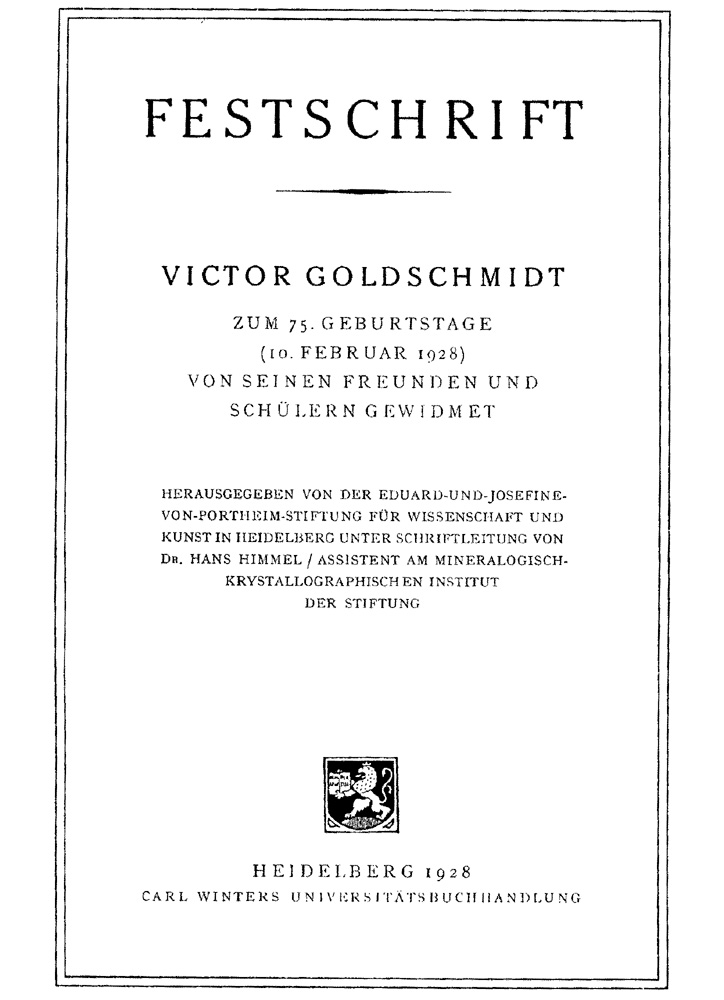
12. German, 1928.
[Contained within a double rule box:] Festschrift | [tapered rule] | Victor Goldschmidt | Zum 75. Geburtstage | (10. Februar 1928) | Von Seinen Freunden Und | Schülern Gewidmet | Herausgegeben Von Der Eduard-Und-Josefine-Von-Portheim-Stiftung Für Wissenschaft Und | Kunst In Heidelberg Unter Schriftleitung Von | Dr. Hans Himmel / Assistant Am Mineralogisch- | Krystallographischen Institut | Der Stiftung | [ornament] | Heidelberg 1928 | Carl Winters Universitätsbuchhandlung.
8°: π2 1-178 183; 141l.; [i]-iv, [1]-275, [3] p., frontispiece (portrait of Goldschmidt), 10 plates (one folding), text illus., biblio. of Goldschmidt's writings to 1928. Page size: 245 x 174 mm.
Contents: [Facing the title page is a frontispiece portrait of Goldschmidt.]; [i-ii], Title page, verso blank.; [iii]-iv, "Inhalt."; [1]-275, Text.; [1 pg], "Nachwort."-signed Hans Himmel.; [1 pg], "Tafeln."; [1 pg], "Erklärung Zu Tafel I."; [At end], 10 plates, numbered I to X (Plate X folding).
Very scarce. Edited by Hans Himmel [1897-?]. This handsome work was published to commerate the anniversary of Goldschmidt's birth. It begins with a somewhat overglowing review of Goldschmidt's life and contributions by L. Milch. Next comes a chronological listing compiled by Himmel of Goldschmidt's 177 publications printed from 1876 to 1925. Following this are 32 papers published in the native languages of the authors on various mineralogical and crystallographic subjects. The tremendous influence Goldschmidt had as a teacher is somewhat indicated by the five languages reproduced in the papers. Each of the authors was either a former student of Goldschmidt's or a professional colleage, many making their own important contributions to these sciences.
Bibliographical references: NUC: 204, 613-6 [NG 0294632].
13. German, 1934.
Kursus der Kristallometrie | von | Dr. Victor Goldschmidt† { }| Geheimem Hofrat, Dr. iur. h.c., Dr. ing. e.h., o. Honorarprofessor | an der Unversität Heidelberg | Aus dem Nachlaß herausgegeben von | [Set in twocolumns] Dr. Hans Himmel | [...4 lines of titles and memberships...] | und | Dr. Karl Müller | [...4 lines of titles and memberships...] | [rule] | Mit 183 Textfiguren | [rule] | Berlin | Verlag von Gebrüder Borntraeger | W 35 Schöneberger Ufer 12a | 1934.
8°: π4 1-108 116; 90l.; [i]-[vii], [1], [1]-167, [1] blank, [4] publisher's list p., subject index, 183 text illus., tables. Page size: 241 x 156 mm.
Contents: [i-ii], Title page, verso "Alle Rechte, insbesondere das Recht der Übertragung in fremde Sprache, vorbehalten ..."; [iii], "Vorbemerkung der Herausgegeber."-dated September \break 1933.; [iv]-v, "Vorwort."-signed V. Goldschmidt, Heidelberg 30 May 1932.; [vi]-vii, "Inhalt."; [1 pg], "Arbeitsregeln."; [1]-160, Text.; 161-162, "Anhang I. Sehnen-Tangententabelle ..."; 163-164, "Anhang II. Winkeltabelle für das reguläre System bei Aufstellung O2 ..."; [165]-167, "Sachregister."; [1 pg], Blank.; [4 pgs], "Verlag von Gebrüder Borntraeger in Berlin ..."
Very scarce. Edited and published postumously from a nearly complete manuscript by Hans Himmel [1897-?] and Karl Müller [?-?]. Goldschmidt's last work is designed as a an authoritative textbook of crystal measurement using one and two circle goniometers. Coming from one of the great practitioners of the art, it is perhaps the finest monograph on the subject. The work gives instruction by the same methods Goldschmidt had applied in teaching forty years worth of post graduate students in his laboratory. It is divided into two sections. The first, the introduction, describes methods of generating gnomonetric, stereographic and orthoscopic projections of crystals. The second covers the measurement of crystals on one and two circle goniometers. By using examples of increasingly complex crystal forms, the theories discussed in the text are reinforced by application. It concludes with examples of measuring twinned crystals. Within the discussion are references to crystal models, crystal making apparatus, and goniometers. The numerous text illustrations show figures of the apparatus, crystal figures and various projections.
Bibliographical references: Dana's 7th (Bibliography): 72. • NUC: 204, 613-6 [NG 0294650].
.